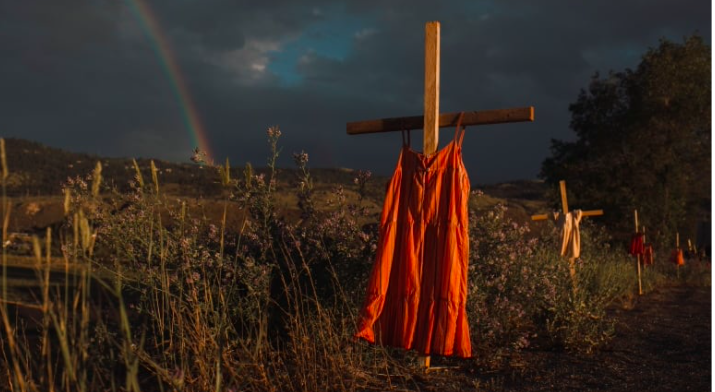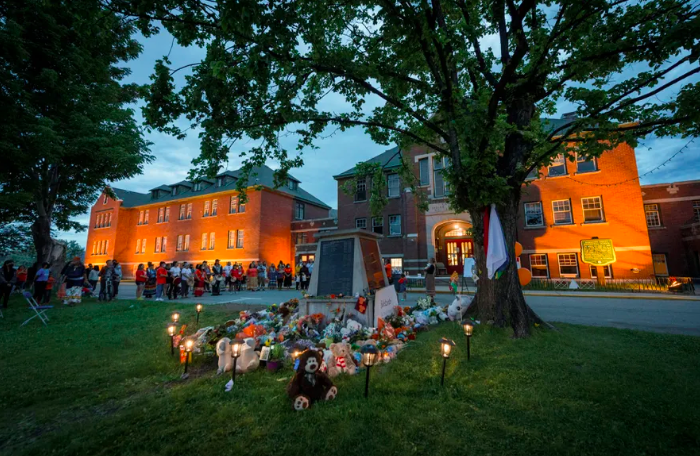Pope Francis began a six-day pastoral visit to North America this week; profusely apologizing to Canada’s Indigenous Peoples' across the nation for the abuse and murder committed by Catholic missionaries in Canadian Indian Residential Schools.
"I’m here because the first step of my penitential pilgrimage is to humbly beg forgiveness for the evil committed by so many Christians against the Indigenous peoples," Francis said, as he disembarked the papal plane in Edmonton on Sunday. "Sorry for the ways in which, regrettably, many Christians supported the colonizing mentality of a government that oppressed the Indigenous peoples."
Indigenous groups are seeking access to church archives to learn the fate of children who never returned home from the country’s notorious residential schools, and an explanation for a massive unmarked gravesite of hundreds of First Nation children at the Kamloops Residential School. The Indigenous Peoples are seeking justice for the abusers, financial reparations, and the return of their artifacts absconded by Vatican museums.
The Indian Residential School System was a network of mandatory boarding schools for Indigenous children. Canada’s Indian Act made attendance for First Nation children compulsory from 1894 to 1947.
Over the course of the residential school system's 100+ year existence, approximately 150,000 children were placed in residential schools across the nation. The number of school-related deaths is unknown, due to incomplete records, but the National Centre for Truth and Reconciliation estimates school-related deaths on par with the mortality rate of Canada's armed forces during World War II, 1-25.
Canada’s Residential School system was mandated by parliament, funded by the Department of Indian Affairs, and administered by the Catholic Church, predominantly. The school system was created “to isolate Indigenous children from the influence of their own native culture and religion,” according to the Indian Act, “in order to assimilate them into the dominant Canadian culture.”
Canada’s Truth and Reconciliation Commission has been soliciting a papal apology to be delivered on Canadian soil since 2015, but it wasn't until the 2021 discovery of the remains of approximately 200+ First Nation children at the former Kamloops Residential School in British Columbia that the Vatican mobilized to comply with the request.

Kamloops Residential School (Amber Beckett)
In 2021, anthropologist Sarah Beaulieu discovered 200+ unmarked graves around the Kamloops Indian Residential School in British Columbia. No remains have been excavated, no claim has been substantiated, but the United Nations has called upon both Canada and the Catholic Church to "conduct full-fledged investigations into the circumstances and responsibilities surrounding these deaths; including forensic examinations of the remains found, and to proceed to the identification and registration of the missing children." On June 6, 2021, speaking to people gathered in St. Peter's Square, Pope Francis commented on the Kamloops Mass Grave Scandal:
This sad discovery increases the awareness of the sorrows and sufferings of the past ... May the political and religious authorities continue to collaborate with determination to shed light on this sad affair and to commit to a path of healing.
Francis’ weeklong trip through Alberta, Quebec and Nunavut, and the Canadian government’s admission that “physical and sexual abuse was rampant in the compulsory Residential School system” both follows Beaulieu’s discovery. But it was the National Centre for Truth and Reconciliation, an archival repository of Canada's Residential Schools, that went to the Missionary Oblates of Mary Immaculate in Rome. Following Beaulieu’s discovery, they Oblates offered “complete transparency and accountability,” allowing the Center unprecedented access to research the names of alleged sex abusers and victims.
The Center located 1,000+ original photos of schools and students with inscriptions on the back and explains, “they’re of immense value to survivors and their families hoping to find traces of their loved ones.” Oblates has agreed on a joint project to digitize the photographs and make them available online.
Canada is extraditing retired Roman Catholic priest Johannes Rivoire (93) from France to face charges of sexual abuse when working among Inuit Tribes in Canada's Residential Schools (1974 – 1979). Five Inuit women accused him in 2017 of sexually interfering with them as children, but it was a 2021 charge – following Beaulieu's revelations — that led to a Canada-wide warrant.
"Many Christians contributed to the policies of cultural assimilation that gravely damaged the Native communities," Francis said, in an address prior to departure from St. Peter's Square. However, many Christians also focused on sabbatical/education opportunities to empower First Nation children to return and re-create a more vibrant Navajo Nation. While these cultures grew together, they're as different as the wheat and the tare.
The Church of Jesus Christ of Latter-day Saints placed 50,000 Native American children in foster homes from 1954-1996. At its peak in 1972, approximately 5000 Native American students were invited from the Navajo Nation, at the Four Corners of the United States, into Caucasian foster homes and schools.
The Indian Relocation Act of 1956 was designed to “create programs of vocational training for Native Americans in the United States.” While critics characterized the law as Indian Termination Politics — a series of laws dedicated to assimilating Native Americans into mainstream American society — the LDS Indian Placement Program was predominantly a success story. Not just due to an 82% graduation rate, higher employment, and higher incomes among foster children. But due, in part, to a legal precedent that returned power and jurisprudence to the Navajo Nation.
In 2016, four plaintiffs from the Navajo Nation filed complaints in the Navajo Nation District Court against LDS Family Services for abuse which occurred during their foster care. The LDS Church, petitioning a declaratory judgement in the U.S. District Court of Utah (rather than the Navajo Nation Tribal Court), effectively became the plaintiff in a federal jurisdiction.
The court denied the church's motion to dismiss — as LDS General Council foresaw it would — thereby setting precedent for all future cases occurring within the Indian Placement Program to be heard in the Navajo Nation Tribal Court — first. The ruling was considered a major victory for tribal jurisprudence, advancing Congresses explicit policy to promote tribal self-governance and the development of tribal court jurisprudence.

Kamloops Residential School Memorial
Moreover, when the Salt Lake City Tribune reported in 1989 that "LDS General Authority George P. Lee has been accused of sexual misconduct by a minor girl,” he was swiftly excommunicated by the First Presidency for "apostasy and other conduct unbecoming of a member of the Church.”
When Lee was later arrested in Washington County Utah in 2007, for failing to register as a sex offender, he'd been effectively monitored by law enforcement for the last 20 years of his life. Unlike Rivorie, or other Catholic Church sexual abuse scandals, both the LDS and Oblates response was swift and transparent, underscoring perhaps the single most critical step of the harvest — timing.
If Francis’ six-day visit was a penitential pilgrimage to apologize for the Catholic Church’s role in the Residential School system, it comes a trifle 128 years too late. "I humbly apologize for the evil committed by Christians in Canada's Residential School system,” Francis said, “but can he just say sorry and walk away,” asked Chief Tony Alexis of the Alexis Nakota Sioux Nation?
LDS Church President Spencer W.Kimball put it this way. "Rationalizing is the bringing of ideals down to the level of one's conduct,” Kimball wrote in The Miracle of Forgiveness.“Repentance is the bringing of one's conduct up to the level of ideals."
One is an act of contrition. The other restitution. And like the wheat and the tare, the two often look and seem eerily similar until harvest time.
Archives










